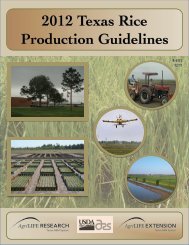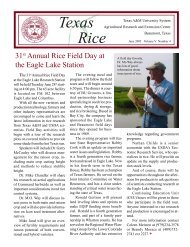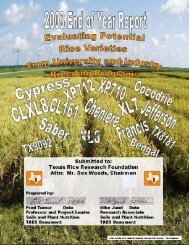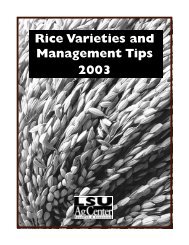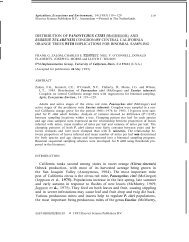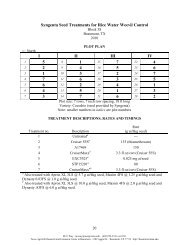2007 - Texas A&M AgriLIFE Research Center at Beaumont - Texas ...
2007 - Texas A&M AgriLIFE Research Center at Beaumont - Texas ...
2007 - Texas A&M AgriLIFE Research Center at Beaumont - Texas ...
You also want an ePaper? Increase the reach of your titles
YUMPU automatically turns print PDFs into web optimized ePapers that Google loves.
Land and Seedbed<br />
Prepar<strong>at</strong>ion<br />
G. N. McCauley<br />
Leveling and drainage consider<strong>at</strong>ions<br />
Fields for growing rice should be rel<strong>at</strong>ively level<br />
but gently sloping toward drainage ditches. Ideally, land<br />
leveling for a uniform grade of 0.2 percent slope or less<br />
provides:<br />
• Necessary early drainage in the spring for early soil<br />
prepar<strong>at</strong>ion, which permits early seeding;<br />
• Uniform flood depth, which reduces the amount of<br />
w<strong>at</strong>er needed for irrig<strong>at</strong>ion; and<br />
• The need for fewer levees.<br />
Importance of early land prepar<strong>at</strong>ion<br />
Successful rice production requires timely land prepar<strong>at</strong>ion.<br />
Therefore, fields should be plowed in the summer<br />
or early fall. Early land prepar<strong>at</strong>ion is particularly critical<br />
when high-residue crops such as grain sorghum or corn<br />
are planted the year before rice. If the land has been out of<br />
production and is grown up in weeds and brush, prepare it<br />
as early as possible.<br />
Early land prepar<strong>at</strong>ion allows several stands of grass and<br />
red rice to be killed by surface cultiv<strong>at</strong>ion before planting.<br />
It also incorpor<strong>at</strong>es the crop residue to assure good decomposition<br />
of plant m<strong>at</strong>erial to prevent early-season nitrogen<br />
deficiency.<br />
If it is not possible to prepare the land early, plant<br />
m<strong>at</strong>erial decomposition will not be <strong>at</strong> advanced stages <strong>at</strong> the<br />
time of planting. The soil’s microorganisms (bacteria, fungi,<br />
etc.) th<strong>at</strong> decompose crop residue will compete with rice<br />
plants for nutrients, particularly nitrogen, causing the rice<br />
plant to be nitrogen deficient. If this situ<strong>at</strong>ion arises, you<br />
may need to add 10 to 20 more units of nitrogen when the<br />
base fertilizer is applied <strong>at</strong> or near planting.<br />
Land prepar<strong>at</strong>ion for rice<br />
after soybean production<br />
Less land prepar<strong>at</strong>ion is needed when rice is planted<br />
after soybeans because the soil is normally left in fairly good<br />
condition. In w<strong>at</strong>er-seeded areas where the land is weed-free<br />
and firm, it may even be feasible to plant rice after reduced<br />
tillage (one or two cultiv<strong>at</strong>ions) of the crop land.<br />
Seedbed prepar<strong>at</strong>ion<br />
Seedbed prepar<strong>at</strong>ion is particularly critical in coarse-textured<br />
soils. The seedbed should be firm and well pulverized<br />
to maintain proper moisture conditions for drilling. This<br />
will ensure rapid germin<strong>at</strong>ion and emergence of the rice<br />
plant.<br />
Although seedbed prepar<strong>at</strong>ion is less critical in areas<br />
where rice is not drilled, it is still important to ensure th<strong>at</strong><br />
the desired soil condition is achieved and to allow rapid<br />
emergence of the rice plant. In all situ<strong>at</strong>ions it is important<br />
to have a weed-free seedbed.<br />
To reduce costs, minimize the number of times a field<br />
is cultiv<strong>at</strong>ed before planting. Avoid “recre<strong>at</strong>ional” passes<br />
over the field. <strong>Research</strong> has shown th<strong>at</strong> fields cultiv<strong>at</strong>ed five<br />
times have about the same average yields as those more<br />
intensely cultiv<strong>at</strong>ed.<br />
The cost of oper<strong>at</strong>ing large tractors for rice production<br />
means th<strong>at</strong> one cultiv<strong>at</strong>ion can cost up to $5 per acre.<br />
Therefore, some farmers are adding as much as $30 per acre<br />
to the cost of land prepar<strong>at</strong>ion and may not be realizing a<br />
corresponding yield increase.<br />
Reduced tillage<br />
Reduced tillage refers to any effort to reduce the number<br />
of land-prepar<strong>at</strong>ion trips across a field. The discussion here<br />
will be restricted to spring and fall stale seedbed techniques.<br />
Spring stale seedbed provides less reduction in cultiv<strong>at</strong>ion<br />
than does the fall stale seedbed technique. The spring<br />
system involves normal fall land prepar<strong>at</strong>ion with early<br />
spring seedbed prepar<strong>at</strong>ion. The seedbed is allowed to set<br />
and weeds germin<strong>at</strong>e. The weeds are controlled chemically<br />
right up to planting. With the spring system, the rice can be<br />
drill- or w<strong>at</strong>er-seeded. For s<strong>at</strong>isfactory stand establishment,<br />
you must use a minimum- or no-till drill.<br />
The major benefit of the spring system is the management<br />
of red rice. For more details on the spring stale seedbed<br />
technique, see the section on Red Rice Control.<br />
The fall stale seedbed technique entails cultiv<strong>at</strong>ion and<br />
seedbed prepar<strong>at</strong>ion in l<strong>at</strong>e summer or early fall. Veget<strong>at</strong>ion<br />
is chemically controlled through the fall, winter and<br />
spring up to planting. The last burn-down applic<strong>at</strong>ion can<br />
be applied with a preplant herbicide applic<strong>at</strong>ion just before<br />
planting.<br />
The major advantage of fall stale seedbed is th<strong>at</strong> it<br />
ensures optimum early planting, particularly in a wet year<br />
when conventional spring field prepar<strong>at</strong>ion is delayed<br />
because of wet field conditions. Equipment and labor costs<br />
can be reduced because fields are not cultiv<strong>at</strong>ed as often<br />
with reduced tillage; however, using burn-down herbicides<br />
can increase the total herbicide cost.<br />
In a conventional cultiv<strong>at</strong>ion system, the condition of the<br />
seedbed is often unknown until planting. This may make it<br />
difficult to select seed r<strong>at</strong>e and to plant. With the fall stale<br />
seedbed technique when veget<strong>at</strong>ion is managed properly,<br />
the seedbed condition is known for weeks or months before<br />
planting. Seeding r<strong>at</strong>e selection and seed booking can be<br />
completed well before planting.<br />
In a fall stale seedbed system, the seeding r<strong>at</strong>e can generally<br />
be reduced 10 to 20 percent when drilling to moisture.<br />
Use a higher seeding r<strong>at</strong>e if a germin<strong>at</strong>ion flush will be<br />
required. This is critical if a preplant herbicide is used.<br />
Planting methods are limited to drill- or w<strong>at</strong>er-seeding<br />
because broadcast seeding requires tillage equipment for<br />
seed incorpor<strong>at</strong>ion. Because the use of a minimum- or<br />
no-till drill is essential, it may be necessary to invest in<br />
additional equipment. There is also the potential for extra<br />
herbicide use.<br />
–––––––––––––––––––––––––––––––––––––––––––––––––––––––––––––––––––––––––––––––––––––



